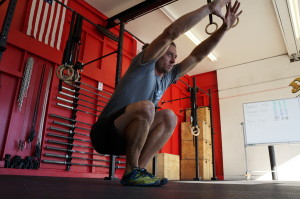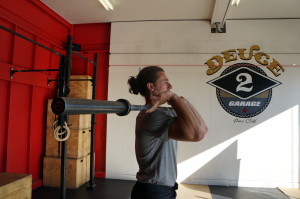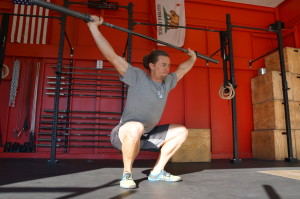As a coach, it often pains me to see an athlete inhibited by things like flexibility. It isn’t so much about a desire for a more flexible universe as much as it is about the desire for people to chase after their full potential. And, for many athletes, a lack of flexibility will blunt their ability to reach their fitness potential.
With that in mind, I put together a list of the top three most desired basic abilities to maximize your training here:
The Ability to Squat with Your Feet Together. This basic position is an indicator of some good hip and ankle flexibility, and will often indicate any short comings in the openness of the thoracic spine. Good butt-to-ankle range of motion with the heels down and big toes touching and connected to the floor is the goal. With this ability, an athlete can build nearly limitless strength and skill to squat, lunge, and even perform pistols. 
The Ability to Rack a Barbell in Shoulder Support. Ideally, this position will leave the bar resting on the deltoids as close to the frontal plane as possible. What we find with athletes that cannot assume this position is that their wrist, triceps, and/or lats limit their ability to raise theirs elbows enough to get the bar off their chest and onto their shoulders.
Without the ability to rack the bar in this position, receiving the barbell for cleans, attempting to press or jerk, and front squatting will be difficult at best, impossible at worst. Being able to bear a load across the shoulders is requisite of most barbell work beyond the deadlift and back squat. 
The Ability to Perform an Overhead Squat. Because the focus of this article is flexibility and necessary ranges of motion, the ability to overhead squat a certain load is moot. The focus here is whether or not, an athlete can move through a full squat with a barbell locked out overhead. Though very simple, this movement can be quite troublesome. The overhead squat, even with little to no load, requires not just ankle, knee, and hip mobility, but an incredible amount of freedom in the shoulders and thoracic spine.
Having capacity in this movement displays shoulder and thoracic spine flexibility that can be utilized in other movements (like pressing a barbell overhead or performing an American swing in the frontal plane without a pelvic tilt/over extension), as well as the obvious required flexibility to being a quest into learning the snatch. 
Don’t have some of these positions? Have no fear, nearly every athlete has a “project” to work on when it comes to general flexibility. These are by no means exceptional displays of flexibility, but rather a necessity to reap all the benefits of functional training. Start chipping away at your range of motion. Once you’ve nailed these three, strength and skill may be your next plan of attack.
Logan Gelbrich
10/16/13 WOD
Complete the following for time:
300ft Shuttle Run
30 KB Snatches (70/53)
30 Box Jumps (30″/24″)
200ft Shuttle Run
20 KB Snatches
20 Box Jumps
100ft Shuttle Run
10 KB Snatches
10 Box Jumps

